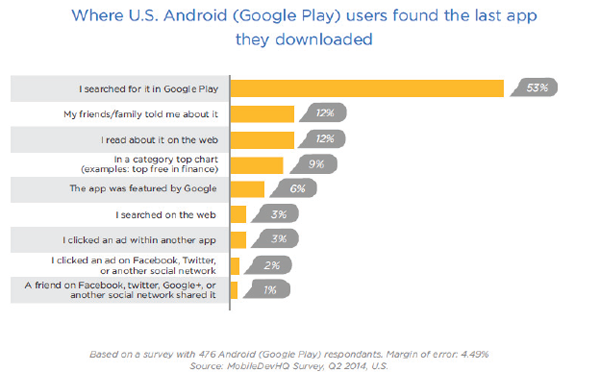3 Best Practices for App Store Optimization

By Allison Howen, Associate Editor
With 1.6 million apps on Google Play alone (as of July 2015 data from Statista), smartphone users have the pick of the litter when it comes to which apps end up on their mobile devices and app store-based search (both on Google Play and Apple's App Store) is the main driver of downloads.
A 2014 survey from MobileDevHQ of app users (64 percent of respondents downloaded an app within the last week) indicated that 53 percent of of those with Android devices found their last app through app store search and 47 percent of iPhone users did the same (see image).

In order to capitalize on these marketplaces, many developers have turned to app store optimization (ASO) techniques to top the search results.
What is ASO?
ASO is defined as the process of improving the visibility of a mobile app in an app marketplace like Apple's App Store or Google Play. Similar to search engine optimization (SEO), there are no formal rules explaining how a developer (or marketer) can win the top spot in an app marketplace's search results. There is, however, a set of best practices that can be leveraged to give developers the edge they need for their apps to be found.
1: Keywords are Key (But Don't Stuff)
Just as keywords are important for a website's SEO initiatives, they are also important when trying to achieve top placement in app marketplaces, but it all comes down to how those keywords are used. Those responsible for marketing a mobile application must include terms and phrases naturally within titles and descriptions, as stuffing keywords into a listing can make descriptions difficult to comprehend, which makes consumers hesitant to download. Moreover, recent rumors suggest Apple will begin cracking down on keyword stuffing particularly within titles, as many developers try to rank higher by creating increasingly lengthy descriptive titles for their apps.
One way to gauge the impact of keywords is by testing different terms and phrases in app descriptions and monitoring how those changes impact the app's placement in search results and total downloads. Fortunately, there are tools available that can help.
SensorTower's App Intelligence platform, for instance, enables users to track daily category and keyword rankings for any app. The platform offers keyword suggestions, keyword difficulty ratings and even a Predictive Rank feature that evaluates the likelihood of a user's app appearing in the top 10 results for any given keyword.
2: Choose Categories Wisely
Not only should developers focus on constructing a comprehensive description for their apps, but they also need to select the right category classification so their apps have a better chance of appearing in relevant searches and user-browsing experiences. It is worth noting that Apple introduced subcategories in iOS 8, which are valuable to marketers because they have less competition than broad categories. This gives apps an even better chance at ranking when consumers are leveraging the "explore"¬ù section of the App Store. For example, under the "Books" category there are a variety of subcategories that developers can file their app under, including "Comics," "Bedtime Stories" and more. This filtering feature not only makes the discovery process easier for consumers, but also makes it easier to increase an app's visibility.
After the Download!
If conversions and monetization are your goals, check out these tips to keep your users engaged and returning often at wsm.co/stickyapps
3: Reel in the (Good) Ratings
Enterprises can improve ASO efforts as well as their total app downloads by obtaining more (good) reviews. After all, good reviews correlate with a quality app, and neither Apple nor Google want to deliver inferior apps to their customers. Luckily, there are some tools that developers and marketers can leverage to ensure their app receives good reviews. For starters, apps should always be thoroughly tested before they are submitted to app stores (at least those not submitted for beta). By conducting tests, developers can catch and fix bugs before consumers have a chance to complain. This minimizes the risk of bad reviews, which can be detrimental to the app's long-term success. Read more about recent beta-testing improvements on Google Play at wsm.co/1clickbeta.
In addition to testing, developers can drive positive ratings by including prompts for user reviews directly within their app. Apptentive, for instance, offers its Intelligent Ratings Prompts tool that enables developers to ask customers to leave reviews while they are interacting with the app.
 For example, the prompt can be created to ask a customer if they "love"¬ù the app (see image); customers who select "Yes"¬ù are prompted to leave a rating and review in the app marketplace, while customers who select "No"¬ù are prompted to provide feedback directly to the app maker.
For example, the prompt can be created to ask a customer if they "love"¬ù the app (see image); customers who select "Yes"¬ù are prompted to leave a rating and review in the app marketplace, while customers who select "No"¬ù are prompted to provide feedback directly to the app maker.
This enables developers to target happy consumers for reviews, while also allowing them to respond to and/or to resolve any issues within the app to lessen the risk of negative reviews in the future.
Keep in mind that apps offering genuine value to consumers are those that will have the best chance of rising to the top of app marketplaces' search results in the long term. With the right positioning, placement and promotion, however, app makers can ensure their products don't get lost in the digital shuffle.

Subscribe to Our Newsletter!
Latest in Marketing








